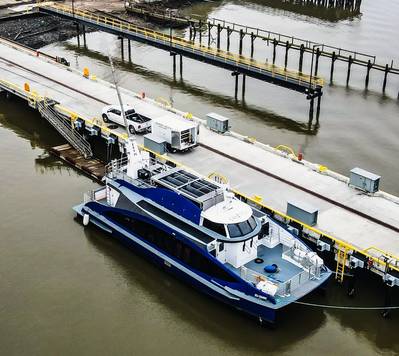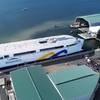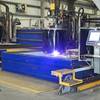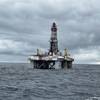Sea Change Completes US' First Hydrogen Refueling
The world’s first hydrogen fueling of a commercial marine vessel was successfully completed, and the vessel is now beginning its final sea trials before delivery, SWITCH Maritime announced.
The new 75-passenger ferry, called the Sea Change, received hydrogen into its 242 kg tanks on the upper deck on November 18 at All American Marine shipyard. It uses that hydrogen in fuel cells producing electricity to power electric motors for distances up to 300 nautical miles, and speeds up to 20 knots – similar capabilities as diesel-powered vessels – with the added benefits of zero exhaust smoke or other emissions and very little vibration and noise.
The fuel loaded in the vessel’s tanks includes green hydrogen, produced in California by an electrolyzer powered with renewable solar power, which results in zero carbon emissions in the production of the fuel as well.
“While it’s taken us years to get to this point, the timing couldn’t be better,” said Pace Ralli, CEO of SWITCH Maritime. “In this moment, our nation is more committed than ever to making the transition to a carbon-free economy. Hydrogen will play a major role in that future, and major players in the maritime industry are ready to decarbonize. We are grateful to all our partners, and proud to play a small role in accelerating the widescale adoption of hydrogen power. Hopefully this is just the first domino to fall.”
The fueling follows the regulatory approval in October by the U.S. Coast Guard (USCG) of the hydrogen powertrain and storage systems onboard the Sea Change, representing the culmination of years of cooperation with the USCG focused on safely integrating hydrogen power and storage systems on passenger vessels. The achievement of this significant milestone unlocks the possibility of many future deployments of similar hydrogen power systems on all vessel types – including oceangoing containerships.
Zero Emission Industries (ZEI), formerly Golden Gate Zero Emission Marine, is responsible for the design and development of the first-of-its-kind maritime hydrogen and fuel cell system as well as the vessel’s unique fueling system that allows it to be fueled directly from a hydrogen truck, and was responsible for the successful regulatory approvals of all hydrogen-related aspects onboard. ZEI is a cutting-edge hydrogen technology company that develops and sells turnkey hydrogen power systems, advanced fuel cell balance of plant sub-systems, fueling systems, and proprietary safety systems for a range of applications.
“We’re super excited to see the Sea Change start sea trials, and I felt proud watching our fueling and hydrogen systems operate in the real world for the first time,” said Danny Terlip, Lead Engineer at ZEI. “Our whole mission at ZEI is to build new technology that makes hydrogen accessible and easy to use, and this event demonstrates how far we’ve come.”
For the fueling during sea trials, SWITCH has engaged West Coast Clean Fuels (WCCF) to develop and permit the end-to-end clean fuel supply chains that will deliver hydrogen to the Sea Change, as well as BayoTech, for high-pressure gaseous hydrogen delivery to Sea Change during sea trials in Washington using transport trailer-to-ship transfer.
SWITCH’s vision is to achieve a fully zero-carbon fueling supply chain of green hydrogen, which is currently in short supply in the U.S. Building more and larger vessels that demand large volumes of hydrogen offtake will increase green hydrogen production volumes, and drive the cost of hydrogen lower than diesel, further advancing the rollout of hydrogen-fueled fleets.
The Sea Change project is managed and financed by SWITCH Maritime, an impact investment firm building the first fleet of exclusively zero-carbon maritime vessels for adoption by existing ship owners and operators. It is the first of the larger zero-carbon ferry fleet that SWITCH plans to construct in 2022, in partnership with municipalities and shipowners aiming to transition to carbon-free vessels, leveraging government grant funds related to transportation decarbonization activities targeted by the landmark US infrastructure bill.
Launched in August at All American Marine shipyard in Bellingham, Wash., the Sea Change is a 70-foot catamaran ferry designed by Incat Crowther, equipped with a hydrogen fuel cell system from ZEI, which includes 360kW of fuel cells from Cummins and 242kg of hydrogen storage tanks from Hexagon Purus, and a 600kW electric propulsion system from BAE Systems which includes 100kWh of lithium-ion battery storage from XALT. The construction management was led by the Hornblower Group. Having successfully performed the first hydrogen fueling, the Sea Change is now performing final operational sea trials prior to delivery from the shipyard and before starting operations in the California Bay Area in Q1 2022.
The project is also partially funded by a $3 million grant from the California Air Resources Board (CARB), administered by the Bay Area Air Quality Management District (BAAQMD), that comes from the California Climate Investments initiative, a California statewide program that puts billions of cap-and-trade dollars to work reducing greenhouse gas emissions, strengthening the economy, and improving public health and the environment—particularly in disadvantaged communities.
Additionally, the project received the first ever loan guarantee under BAAQMD’s Climate Tech Finance program, which seeks to reduce greenhouse gases by accelerating emerging climate technologies. In partnership with the California Infrastructure Economic Development Bank and the Northern California Financial Development Corporation (NorCal FDC), the Climate Tech Finance team led a technology qualification and greenhouse gas analysis that deemed SWITCH eligible for a loan guarantee. This loan guarantee supported SWITCH in securing a $5 million construction and term loan with KeyBank, which enables SWITCH to bring this important project to completion.












